10th January 1891HMS Terpsichore, the twelfth Apollo class second class cruiser, joins the Royal Navy. Unfortunately, just at the time when the Royal Navy needs to expand to counter large alien fleets, the Empire is suffering a shortage of Duranium. No more Apollos are under construction.
11th January 1891A large fleet from the Hegemony of Titan has joined the Martian fleet in orbit of the Roanoke colony. The Hegemony force includes five 19,189-ton Gungnir class, five 12,777-ton Asgard class, four 12,690-ton Gladsheim class, two 12,767-ton Garm class, three 6390-ton Hel class, three 6.356 Tyr class, a 6390 –ton Troll class and a 6390-ton Thor class, all of which are capable of 3286 km/s. Naval Intelligence applies the same classification for hull designations to the Hegemony designs as was used for the Martian Empire. Those ships above 12,000 tons are classed as battleships, while those above 6000 tons are classed as protected cruisers.
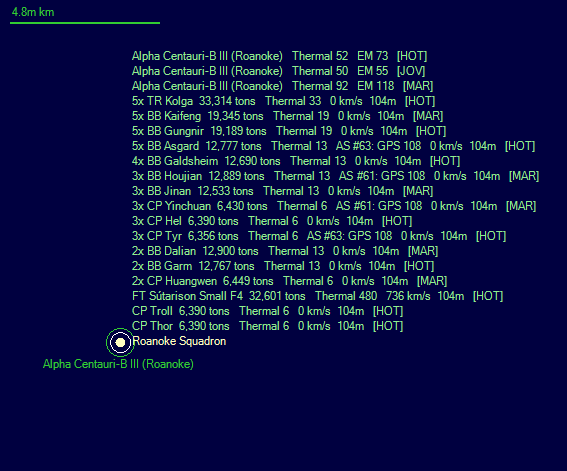 27th February 1891
27th February 1891The Venusian Khanate establishes a colony on Alpha Centauri-B III, site of the Roanoke colony. All five Solarian powers now have colonies on the planet.
14th March 1891A jump point is discovered in the Vogel system, beyond Sol’s outermost jump point. HMS Medea conducts the probe and arrives in another of the Vogel Star Catalogue systems, appropriately enough as the system from which she arrived was named after the creator of the catalogue. The system is a red dwarf binary with a planetless primary and three tide-locked planets, including two superjovians, orbiting the companion star. The recently formed Royal Naming Commission designates the new system as Thrace.
20th March 1891Two new Ambrosia class fuel harvesters are launched from the Thorneycroft Shipyard. The existing eight harvesters are all in orbit of Aeolis IV, a superjovian two transits from Earth with three hundred million tons of accessibility 0.9 Sorium. As this is likely to be the Royal Navy’s primary fuel supply for many years, a fleet base was established at the New Plymouth colony on Aeolis II in August 1890. That base has recently been expanded. The New Plymouth Squadron comprises the protected cruiser HMS Hawke and the second class cruiser HMS Terpsichore.
23rd April 1891HMS Pioneer detects two jumps point in Lalande, the only known system beyond Alpha Centauri, which are barely more than forty million kilometres apart. One jump point has already been stabilised, which demonstrates how far ahead the alien powers are in the survey efforts. The Medea class second class cruiser HMS Magicienne is dispatched from Earth to investigate.
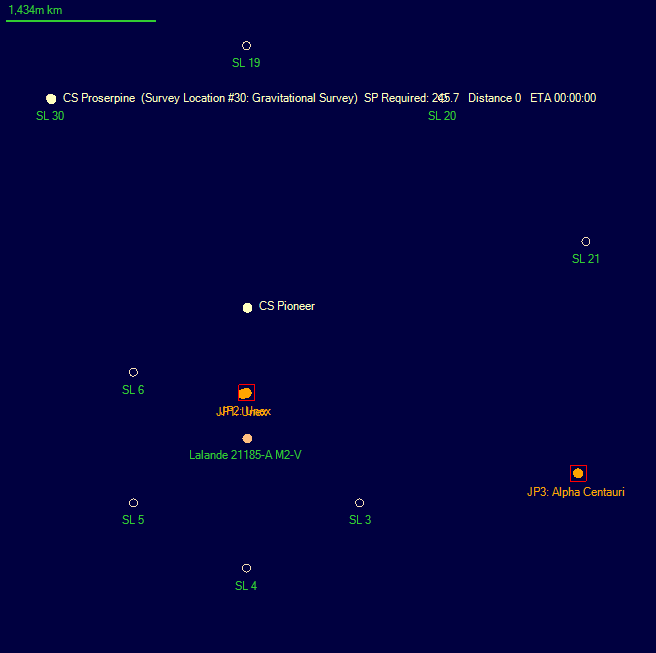 25th April 1891
25th April 1891HMS Medusa transits a recently discovered jump point in Aeolis. She emerges in the Alexandria system, which has an orange K4-V primary, eleven planets, ninety-three moons and two hundred and thirty asteroids. The entry jump point is close to the edge of the system at four and a half billion kilometres. While none of the many system bodies are even close to habitable, the star is relatively young at three billion years so there is a higher chance of finding mineral deposits.
26th April 1891HMS Perseus encounters a Martian Xian class ship while conducting her gravitational survey of Aeolis. Naval Intelligence classifies the Xian as a gravitational survey vessel.
30th April 1891HMS Perseus and HMS Psyche discover two more jump points in Aeolis. HMS Medusa investigates. The first system is 61 Cygni, which first attracted the attention of astronomers when its large proper motion was first demonstrated by Giuseppe Piazzi in 1804. In 1838, Friedrich Bessel measured its distance from Earth at about 10.4 light-years, very close to the actual value of about 11.4 light-years; this was the first distance estimate for any star other than the Sun, and the first star to have its stellar parallax measured. Among all stars or stellar systems listed in the Vogel Star Catalogue, 61 Cygni has the seventh-highest proper motion, and the highest among all stars or systems visible from Earth.
The system has two K-class stars with masses around two-thirds of the Sun. The primary has seven planets, including three colony cost 2.00 tide-locked terrestrial worlds and two gas giants with fifty moons between them. 61 Cygni IV has a nitrogen – oxygen atmosphere of 0.23 atm, large seas covering thirty-eight percent of the surface and a temperature of -5C, making it an excellent candidate for terraforming. The B component has five planets and seven moons. A dwarf planet and two of the moons have ice sheets but no atmospheres. They range between colony cost 3.98 and colony cost 4.84. HMS Medusa scouts 61 Cygni-A IV as it has an atmosphere that could support some form of life, then heads back into Aeolis to check the second of the new jump points.
6th May 1891Meanwhile, HMS Magicienne arrives at the pair of jump points in Lalande. The first leads to Tegea, a red dwarf star with a single, unremarkable terrestrial world. The second connects to Epsilon Indi, a trinary star system with an orange K5-V primary and a pair of brown dwarfs orbiting each other over two hundred billion kilometres away. The constellation Indus (the Indian) first appeared in Johann Bayer's celestial atlas Uranometria in 1603. The star atlas Uranographia, produced in 1801 by German astronomer Johann Elert Bode, places Epsilon Indi as one of the arrows being held in the left hand of the Indian. The two brown dwarfs, both of which are planetless, were discovered much more recently.
The primary has only two planets. The inner is a terrestrial world with a nitrogen – oxygen atmosphere of 0.284 atm and a surface temperature of -11C. However, there is no water on the surface, making the planet much harder to terraform. Epsilon Indi-A II is a gas giant with ten moons. HMS Magicienne moves back into Lalande, where she will remain for the moment in case any further jump points are discovered.
15th May 1891HMS Medusa transits the remaining unexplored jump point in Aeolis and discovers a red dwarf system with six comets but no planets. The system is named Smyrna.
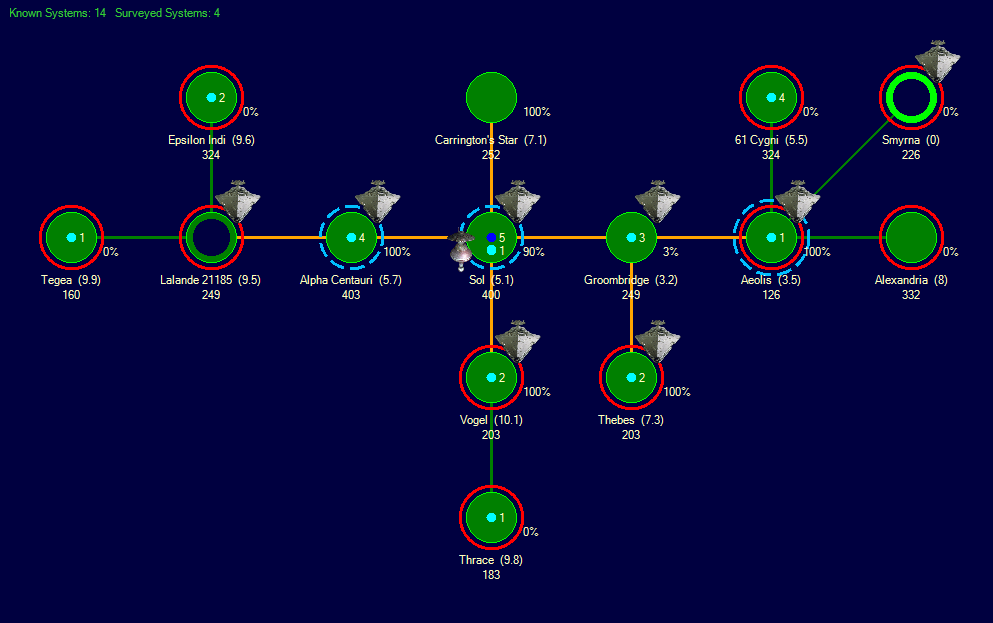 20th May 1891
20th May 1891A new colony of the Venusian Khanate is detected on Alpha Centauri-B II. The planet is not particularly appealing for a colony, as it has a nitrogen – methane atmosphere of 0.87 atm and a surface temperature of 81C. There are extensive mineral deposits but mostly at minimal accessibility. The new colony makes the situation in the Alpha Centauri-B solar system even more complex.
Alpha Centauri-B II Survey ReportDuranium: 11,491,218 0.20
Neutronium: 141,376 0.10
Corbomite: 3,024,121 0.10
Mercassium: 1,069,156 0.10
Vendarite: 13,786,369 1.00
Uridium: 2,862,864 0.10
Gallicite: 4,879,681 0.10
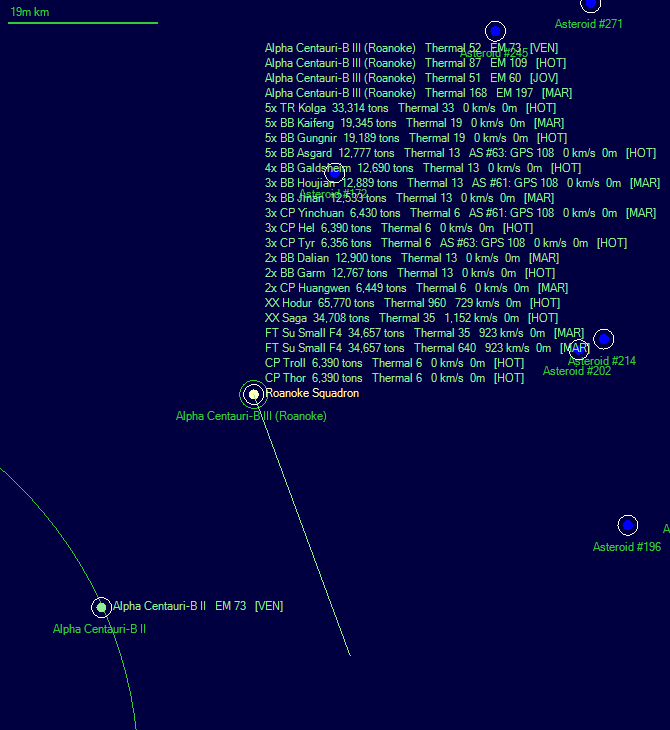 24th May 1891
24th May 1891The gravitational survey of Thebes is completed by HMS Pandora. No jump points were discovered. She heads back through the Groombridge system to Earth, where she will begin an overhaul.
4th June 1891Two new survey cruisers, HMS Pomone and HMS Pyramus, are launched from the Portsmouth Dockyard orbital shipyard. They will be assigned to geological surveys of the recently discovered systems. A British civilian mining colony, Bowen Mining and Refining, is established on Haumea in the Sol system.
30th June 1891HMS Pelorus, conducting a geological survey of Thrace, is joined in orbit of the third planet by a Hegemony Woden class ship of 5,573 tons. As the planet is a superjovian, this is sufficient for Naval Intelligence to class the Woden as a geological survey vessel.
11th July 1891The gravitational survey of Aeolis is complete. Four jump points have been identified; the entry point from Groombridge plus the connections to 61 Cygni, Alexandria and Smyrna. The fleet base at New Plymouth on Aeolis II has been upgraded again to support up to 17,600 tons of shipping. The jump-capable second class cruiser HMS Medusa has been added to the New Plymouth Squadron.
15th July 1891British shipwrights and scientists have combined their efforts to build a new weapon; the Twin 3” QF Gauss Cannon Turret. The new turret is combined with a new fire control that will allow it to engage torpedoes moving at up to 16,000 km/s without loss of accuracy. This weapon will replace the 4” QF Railgun on future designs. Shipyards have also been expanded in the last two and a half years so those same shipwrights have created three new ship designs that are larger and more capable than their current equivalents.
The Canopus class battleship is one-third larger than the Majestic class and has increased armour protection. The number of 8" Ultraviolet Lasers has been increased from four to six and the six 4” QF Railguns have been replaced by two Twin 3" QF Gauss Cannon Turrets. The small secondary fire control systems have been replaced by two fast-track fire control systems. Finally, the Canopus has a spare reactor to ensure it can suffer damage and keep fighting at full capacity. This new design will bring Royal Navy battleships into line with the larger Martian and Hegemony battleships. The Devonport Shipyard, which is currently building the last two Majestics, will begin retooling immediately. The first Canopus should be laid down in May 1892.
Canopus class Battleship 20,000 tons 519 Crew 2,894.5 BP TCS 400 TH 1,600 EM 0
4000 km/s Armour 8-65 Shields 0-0 HTK 113 Sensors 15/5/0/0 DCR 11 PPV 92.64
Maint Life 2.02 Years MSP 1,017 AFR 284% IFR 4.0% 1YR 331 5YR 4,964 Max Repair 200 MSP
Captain Control Rating 1 BRG
Intended Deployment Time: 12 months Morale Check Required
Parsons P400 Triple Expansion Stardrive (4) Power 1600 Fuel Use 40.0% Signature 400 Explosion 10%
Fuel Capacity 858,000 Litres Range 19.3 billion km (55 days at full power)
8" Ultraviolet Laser (6) Range 256,000km TS: 4,000 km/s Power 10-4 RM 40,000 km ROF 15
5" QF Ultraviolet Laser (6) Range 160,000km TS: 4,000 km/s Power 4-4 RM 40,000 km ROF 5
Twin 3" QF Gauss Cannon Turret (2x6) Range 10,000km TS: 16000 km/s Power 0-0 RM 10,000 km ROF 5
Dreyer Primary Fire Control System (2) Max Range: 256,000 km TS: 4,000 km/s 96 92 88 84 80 77 73 69 65 61
Dreyer Fast-Track Fire Control System (2) Max Range: 64,000 km TS: 16,000 km/s 84 69 53 38 22 6 0 0 0 0
R16 Improved Pebble Bed Reactor (4) Total Power Output 65.2 Exp 5%
Type 1 Active Search Sensor (1) GPS 7560 Range 50.5m km Resolution 105
Type 10 Torpedo Detection Sensor (1) GPS 4 Range 2.4m km MCR 260.7k km Resolution 1
Type 2 EM Sensor (1) Sensitivity 5 Detect Sig Strength 1000: 17.7m km
Type 5 Thermal Sensor (1) Sensitivity 15 Detect Sig Strength 1000: 30.6m km
The Diadem class Protected Cruiser is fifty percent larger than the preceding Edgar class and is almost as large as the smaller alien battleship designs. The Diadem has increased armour protection and significantly upgraded armament. The number of 6" C3 Ultraviolet Lasers has been doubled to four, a fourth 5" QF Ultraviolet Laser has been added and the three 4" QF Railguns have been replaced by a Twin 3" QF Gauss Cannon Turret. A fast track fire control system has replaced the older secondary fire controls and the torpedo detection sensor has been upgraded. The Chatham Dockyard should complete retooling for the new design at the end of December 1891, shortly after it completes the last two Edgar class protected cruisers.
Diadem class Protected Cruiser 11,250 tons 301 Crew 1,590.8 BP TCS 225 TH 900 EM 0
4000 km/s Armour 6-44 Shields 0-0 HTK 67 Sensors 5/5/0/0 DCR 6 PPV 52.32
Maint Life 2.20 Years MSP 530 AFR 169% IFR 2.3% 1YR 147 5YR 2,210 Max Repair 150 MSP
Commander Control Rating 1 BRG
Intended Deployment Time: 12 months Morale Check Required
Parsons P300 Triple Expansion Stardrive (3) Power 900 Fuel Use 46.19% Signature 300 Explosion 10%
Fuel Capacity 576,000 Litres Range 20 billion km (57 days at full power)
6" C3 Ultraviolet Laser (4) Range 240,000km TS: 4,000 km/s Power 6-3 RM 40,000 km ROF 10
5" QF Ultraviolet Laser (4) Range 160,000km TS: 4,000 km/s Power 4-4 RM 40,000 km ROF 5
Twin 3" QF Gauss Cannon Turret (1x6) Range 10,000km TS: 16000 km/s Power 0-0 RM 10,000 km ROF 5
Dreyer Primary Fire Control System (2) Max Range: 256,000 km TS: 4,000 km/s 96 92 88 84 80 77 73 69 65 61
Dreyer Fast-Track Fire Control System (1) Max Range: 64,000 km TS: 16,000 km/s 84 69 53 38 22 6 0 0 0 0
R15 Improved Pebble Bed Reactor (2) Total Power Output 29.8 Exp 5%
Type 6 Active Search Sensor (1) GPS 3780 Range 35.7m km Resolution 105
Type 11 Torpedo Detection Sensor (1) GPS 12 Range 4.4m km MCR 475.9k km Resolution 1
Type 2 EM Sensor (1) Sensitivity 5 Detect Sig Strength 1000: 17.7m km
Type 4 Thermal Sensor (1) Sensitivity 5 Detect Sig Strength 1000: 17.7m km
The Eclipse class Second Class Cruiser will fulfil the escort role current taken by the four 3,750-ton Astraea class second class cruisers. The two Twin 3" QF Gauss Cannon Turrets of the Eclipse, combined with the fast-track fire control system, should be twice as effective against hostile torpedoes compared to the Astraea’s six 4" QF Railguns, although the Astraea would be more effective in an anti-ship role. The Eclipse also has improved armour protection and a more capable sensor suite compared to its smaller predecessor. The Pembroke Dockyard is retooling to build the Eclipse and should lay down the first ships in January 1892. There are no plans for the moment for a successor to the twelve Apollo second class cruisers or the four Medea jump-capable second class cruisers as they are intended primarily for scouting and patrol duties and to provide a presence at colonies.
Eclipse class Second Class Cruiser 6,000 tons 134 Crew 799.4 BP TCS 120 TH 480 EM 0
4000 km/s Armour 4-29 Shields 0-0 HTK 34 Sensors 5/1/0/0 DCR 3 PPV 32.64
Maint Life 2.02 Years MSP 249 AFR 96% IFR 1.3% 1YR 81 5YR 1,218 Max Repair 120.00 MSP
Commander Control Rating 1 BRG
Intended Deployment Time: 12 months Morale Check Required
Parsons P240 Triple Expansion Stardrive (2) Power 480.0 Fuel Use 51.64% Signature 240.00 Explosion 10%
Fuel Capacity 362,000 Litres Range 21 billion km (60 days at full power)
Twin 3" QF Gauss Cannon Turret (2x6) Range 10,000km TS: 16000 km/s Power 0-0 RM 10,000 km ROF 5
Dreyer Fast-Track Fire Control System (2) Max Range: 64,000 km TS: 16,000 km/s 84 69 53 38 22 6 0 0 0 0
Type 11 Torpedo Detection Sensor (1) GPS 12 Range 4.4m km MCR 475.9k km Resolution 1
Type 7 Active Search Sensor (1) GPS 1200 Range 20.3m km Resolution 100
Type 9 EM Sensor (1) Sensitivity 1 Detect Sig Strength 1000: 7.9m km
Type 4 Thermal Sensor (1) Sensitivity 5 Detect Sig Strength 1000: 17.7m km
26th July 1891A new armoured regiment, the 2nd Dragoon Guards (Queen's Bays), is trained on Earth.
28th July 1891The New Haven colony of 200,000 settlers is established on Epsilon Indi-A I, three jumps from Sol via Alpha Centauri and Lalande. The planet has a thin atmosphere of 0.28 atm of nitrogen and 0.006 atm of oxygen, but lacks both water and any accessible mineral deposits. The colony is intended to provide a presence in the system, which is on a possible route for further exploration, and to provide the site for a potential future naval base location. A tracking station was landed with the first colonists.
1st August 1891The Providence colony of 200,000 settlers is established on 61 Cygni-A IV, three jumps from Sol via Groombridge and Aeolis. As with the New Haven colony, the primary intention is to establish a presence in the system and deploy a tracking station. However, in this case the atmosphere of 0.23 atm already includes 0.043 atm of oxygen and large seas cover more than a third of the surface area, making the planet an excellent candidate for terraforming. Unfortunately, there are no mineral deposits.
15th August 1891Five 44,415-ton Heimdall class ships of the Hegemony of Titan arrive in orbit of Aeolis IV, accompanied by a 12,777-ton Asgard class battleship and a Tyr class protected cruiser. Aeolis IV is the Royal Navy’s primary fuel production location and ten Ambrosia class harvesters are in orbit. Naval Intelligence classes the Heimdall as a fuel harvester.
16th August 1891The civilian White Star Line launches its fourth ship. Two freighters, a colony ship and a liner are now in service with the shipping line.
8th September 1891HMS Magicienne transits a new jump point in Tegea, three jumps from Sol via Alpha Centuari and Lalande. She discovers a red dwarf from the Vogel Star Catalogue with six planets and over fifty moons. The Royal Naming Commission assigns the name of Corinth. Corinth II is the most interesting planet with a nitrogen – oxygen atmosphere of 0.89 atm, including 0.027 atm of oxygen. However, the planet lacks water and the surface temperature is -43C. A terraforming candidate but not high priority unless a geological survey reveals accessible deposits.
14th October 1891HMS Magicienne is providing support to the survey operations around Epsilon Indi and Tegea, sometimes referred to as the Twin Systems because the jump points from Lalande to the two systems are so close together. She moves from the latter to the former and investigates a new jump point located by HMS Proserpine. It leads to the planetless K-class star Groombridge 1618. This star was first identified as entry 1618 in the work A Catalogue of Circumpolar Stars by Stephen Groombridge published posthumously in 1838. As there is already a system named after Groombridge, the Royal Naming Commission renames the system to Tyras.
16th October 1891A large force from the Venusian Khanate has moved into orbit of Alpha Centauri-A II, home to the Jamestown colony and a Venusian colony. Jamestown has a population of four million and a small fleet base with a capacity of 11,200 tons. The Venusian colony seems to be slightly smaller based on its EM and thermal signatures. Working on the assumption that all Venusian ships with a speed of 3161 km/s are warships, Naval Intelligence believes the Venusian fleet is even more powerful than the Martian and Hegemony fleets in orbit of Roanoke.
The Venusian fleet includes five 25,603-ton Yuan class battleships, three 17,078-ton Chakhar class battleships, three 17,071-ton class Timurad class battleships, two 17,050-ton Mughal class battleships, three 8,541-ton Hazara class protected cruisers and two 8,509-ton Manchu class protected cruisers. The Royal Navy squadron in Jamestown orbit comprises the Apollo class second class cruisers HMS Andromache and HMS Indefatigable, each of 3,750 tons.
28th October 1891HMS Magicienne returns to Tegea to investigate a jump point detected by HMS Pomone. She transits and finds herself in the already known Groombridge system. The new link brings Tegea within two jumps of Sol.
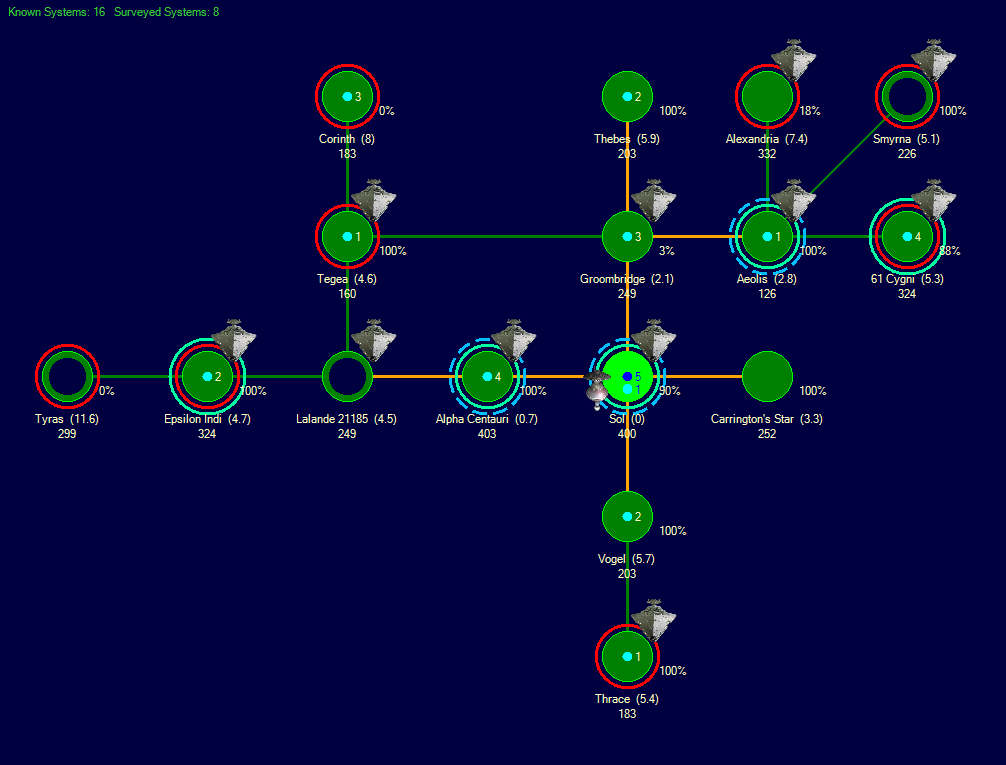 19th November 1891
19th November 1891The 6th Infantry Division is formed, comprising the Princess of Wales's Own (Yorkshire Regiment), the Royal Irish Regiment, the Royal Scots Fusiliers and the Lancashire Fusiliers. The division is deployed to the growing New Plymouth colony on Aeolis II. The New Plymouth Squadron has been reinforced and comprises the Edgar class protected cruisers HMS Hawke and HMS St George, the Medea class second class cruiser HMS Medusa, the Apollo class second class cruiser HMS Terpsichore and the Astraea class second class cruiser HMS Cambrian.
23rd November 1891HMS Gibraltar and HMS Royal Arthur, the last two Edgar class protected cruisers to be constructed, launch from the Chatham Dockyard orbital shipyard. There are eight Edgars in total. Within a few weeks, Chatham Dockyard will begin work on the first Diadem class protected cruisers.
5th December 1891The gravitational survey of Thrace is completed without finding any jump points. As Thrace is the only system beyond Vogel, that ends any further exploration via Sol’s outermost jump point. As Carrington’s Star was also a dead-end system, Alpha Centauri and Groombridge are the only routes out of Sol.
30th December 1891HMS Magicienne transits the first jump point to be discovered in Corinth and emerges in Tau Ceti, which has a yellow G8-V primary, thirteen planets and almost one hundred and fifty moons. Tau Ceti is the Bayer designation for this star, established in 1603 as part of German celestial cartographer Johann Bayer's Uranometria star catalogue. The second planet and three moons of the third planet are colony cost 2.00, although they all lack water and atmosphere.
Note: To speed the testing along, I have reduced the truce countdown by 5 years. It will now run out in 2 years from this point.